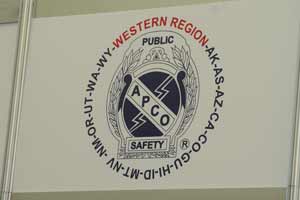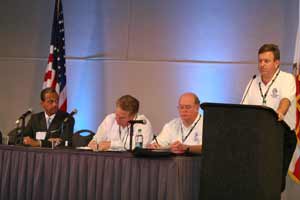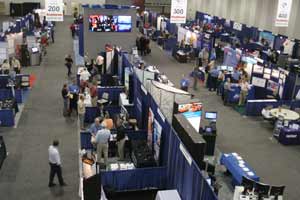Views from the West
Approximately 600 public safety communications professionals from across the Western Region of the U.S. — representing every state — gathered in Ontario, Calif., this week for the 2011 APCO International Western States Regional Conference. Hosted by CPRA (California Public-Safety Radio Association), APCO’s Southern California Chapter, the conference offered opportunities to learn, act and connect.
Technology was a hot topic this year. The more than 40 educational tracks covered the latest on P25, LTE and Next Generation 9-1-1, as well as social media and its effects on comm center policies and its use in emergency alerting. Telecommunicators, managers, IT and RF professionals alike were sure to find sessions that would further their careers and benefit their centers.
The conference was co-located with APCO International’s inaugural Technology Roundtable, an event designed for a small group of professionals to gather in an intimate setting and discuss the technology concerns and industry trends most important to them. (Click here for a full report on this event.)
Opening Session
Bernard K. Melekian, director of the U.S. Department of Justice’s Office of Community Oriented Policing (COPS), was this year’s keynote speaker.
In his address, “Advancing Public Safety in a Changing Economy,” Melekian presented a vision of public safety that would result from the current economic difficulties, but keep our cities viable. Referencing the book, The City, by Max Weber, Melekian stated that for cities to be viable, they must be scared (i.e., having a sense of place and calling people to serve it), safe (i.e., citizen’s don’t have to worry about their personal safety) and busy (i.e., economically productive).
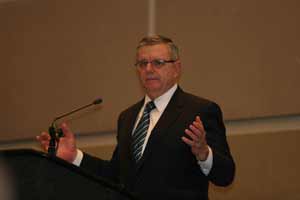
Bernard K. Melekian, director of the U.S. Department of Justice’s Office of Community Oriented Policing (COPS), was this year’s keynote speaker.
“I believe delivery of public safety services and law enforcement services over the next three to five years is going to change,” he said. “The discussions about what those changes will look like will be significant.”
He continued, “I think the economy will recover, but I also think it is unlikely that a city manager and county administrators are going to go back to a time where public safety was consuming 30, 40, 50% of their budgets. The roles of communications and technology [are] going to be critical. … I think it’s unlikely that we will go back to how we have always done things.”
In this economic environment in which agencies are laying off police officers and looking toward consolidation to share expenses, resources and infrastructure, Melekian believes public safety will have to find a different approach for delivering its core services of emergency response, quality of life management and community outreach. He noted that many police chiefs have been telling him about their plans to cut community-oriented policing programs as a result of tight budgets.
His response: “If they are doing that, then community[-oriented] policing was not the priority of the department — it was a special program. The importance of community[-oriented] policing is becoming more important. … Community[-oriented] policing is not rocket science. It’s about building relationships with people and solving their problems. The role of the communications officer and the PSAP in the project is critical.”
To free up law enforcement resources to accomplish community[-oriented] policing, Melekian suggested a greater use of civilian employees and volunteers by public safety agencies. This change would free up sworn officers for patrols. He noted, “The Denver Police Department is a great example, and went from none to 1,000 citizen volunteers.” Many of these volunteers have specialties and are certified technicians.
Melekian also said there will need to be greater reliance on technology and scheduling of non-emergency calls. He said, “Like a utility, saying we will be coming out between times, handling [calls for service] through online reporting or video conferencing.”
“We are going to see greater regionalization and consolidation,” he said. “That is not a Department of Justice position, but it does appear to be being driven by the economy at the local level. As those mergers occur, the ability to merge technology and share commonly used resources [will improve].”
To aid public safety agencies in making some of these changes, Melekian announced that the COPS office will be revising its grant protocols. Instead of focusing on hiring, it will encourage applications that include multi-agency partnerships and that are looking to fund civilian positions.
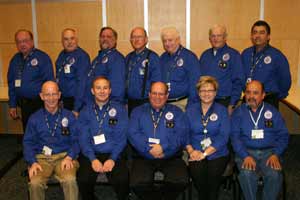
After the original host chapter was unable to hold the conference, CPRA stepped in to save the day. Members of the CRPA Conference Committee had little more than 6 months to pull together this year's conference, which was a success.
Melekian also brought up broadband technology and public safety’s fight to obtain 10 MHz of spectrum known as the D Block for a nationwide interoperable public safety broadband network. “The president has call for the reallocation of the D Block to be used by public safety and has proposed funding. … The proposed network will benefit the field and will enhance public safety, achieving a level of interoperability than ever would have been thought possible.
“The change coming, I believe, is inevitable,” he said. “It will be driven by the economy and the need for local agencies to better define what public safety means and the shift of public expectations.”
The Fate of the D Block
Immediately after the opening session, Melekian and his colleagues from the U.S. Department of Justice gathered for a panel presentation called Public Safety Broadband: What’s Next? Speakers included Deputy Associate Attorney General Marisa Chun, COPS Program Assistant Director David Buchanan and Joseph Heaps, deputy director of the Information and Sensor Technologies Division for the National Institute of Justice.
The panel addressed how the Obama administration arrived at the policy of reallocating the D Block to public safety and how it expects to fund a nationwide interoperable broadband network for public safety. The system is expected to be included in the president’s 2012 budget.
Last summer, Obama announced his spectrum initiative, which called for the auction of 500 MHz of spectrum to the commercial sector to encourage innovation.
“The president cares deeply about innovation,” said Chun. “America needs to remain a leader and in that larger focus on technology, and public safety has a commitment to invest. We want to have a strong and stable environment to foster economic growth and innovation. The D Block going to public safety should not hinder the private sector but promote innovation. … [We] need to think in the long term. We still need to invest in infrastructure and innovate and build and educate in these tough times. The men and women in public safety who protect our county and families need the best technology available. The president’s spectrum initiative could be a revenue source to help the network. Public safety would stand first in line for auction revenues.”
According to Chun, there is a lot of hard work ahead, and the reallocation of the D Block may prove to be the easiest aspect of achieving the network.
(Click here to view the Feb. 10 statement from the White House.)
Town Hall
Among the more high-profile attendees at the conference were members of the APCO International Executive Committee: President Bill Carrow, First Vice President Gregg Riddle and Second Vice President Terry Hall. These leaders joined APCO Executive Director George S. Rice Jr. for a town hall meeting designed to give APCO members the ability to communicate directly with their leadership.
Carrow opened up the session by immediately calling for questions, allowing attendees to ask questions. Topics raised by the crowd included committee updates, narrowbanding and the upcoming election of the Executive Committee.
Carrow reported on the work of two committees formed after the Houston conference, the Broadband Committee and CALEA Committee. The Broadband Committee is chaired by Bill Schrier and vice chaired by Andy Seybold,
According to Carrow, this committee had to hit the ground running this year. “Timing is everything. As we stood them up, by the end of the week we had issues coming out of the FCC. We would have had nowhere to vet the issues [without the committee]. These are broadband. I don’t think [committee members] would have had the prominence or got out the gate as quick with issues [in August] because [issues] were staring them in the face as soon as we stood them up.”
Carrow also reported on the success the new CALEA Committee has had working with the APCO Institute Advisory Committee to develop and deploy the new CALEA Public Safety Communications Accreditation Manager Course. The first eight-week course was filled within one week of its initial announcement.
Joe Hanna, past APCO president and current member of the APCO Credentialing Committee, raised an important topic: the future of the APCO Executive Committee.
“This year we had one candidate,” he said. “I find it a high level of frustration that in an association of 14,000 members, we basically have now only eight volunteers to step up to serve on the board. I wanted to make it very clear there’s no issue about the candidate we have certified, but there is a concern that as an association of 14,000 members, we were fortunate to have someone come in the last week to volunteer [to lead].”
Hall brought up another aspect of the upcoming election. “Two people put forth nominations; one withdrew,” he said. “The SGI is good for a long-term structure to mentor people to be on the Executive Committee, but it’s an evolutionary process. Someone came out and announced their intention [to run] and that put some other people off. Steps taken by the SGI support what you’re saying; it’s an evolutionary process, and this year we just got jammed up in it.”
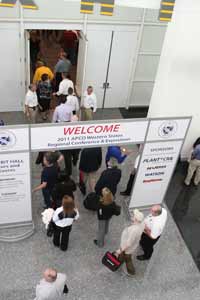 Rice elaborated, “There is a feature of association culture: Individuals will run before the election. They socialize their intent to run. As a result, those who do not feel they can prevail will withdraw before putting their nomination out there. This is common in association culture, but it is acute with APCO. It is a symptom of an unhealthy environment — I will be candid — and it can be fixed.”
Rice elaborated, “There is a feature of association culture: Individuals will run before the election. They socialize their intent to run. As a result, those who do not feel they can prevail will withdraw before putting their nomination out there. This is common in association culture, but it is acute with APCO. It is a symptom of an unhealthy environment — I will be candid — and it can be fixed.”
The panelists requested that attendees help educate the membership that the level of commitment required of Executive Committee members has changed, as well as encourage new leadership within the association. Carrow said, “We need good, qualified people willing to step up. We’ve changed our meeting schedule. We have conference calls when we can. It’s not a 90-hour-a-week job like it used to be.”
Rice reported on the association’s work on the international level. APCO has been working the APCO Global Alliance to hold the first APCO World Congress in June.
The event has received sponsorships and 50% of the show floor has been sold. APCO International has also been working with contacts in the Caribbean, who plan to hold a small event in Costa Rica. APCO International will be on a panel at this event. There has also been discussion about a regionwide event in which APCO International will be a major participant.
FCC ‘in’ Ontario
On Tuesday morning, attendees had the opportunity to learn about FCC’s process for handling compliance with National Environmental Policy Act (NEPA) and Section 106 of the National Historical Preservation Act. Hosted by Amos J. Loveday of Atchley Hardin Lane LLC, a former state historical preservation officer for Ohio, the panel included Washington officials representing the FCC, the National Conference of State Historic Preservation Officers and the National Association of Tribal Preservation Officers joining via live video conferencing.
The overall goal of the panel was to encourage FCC licensees to reach out to the Commission and their state historical preservation officer before investing too much time and too many resources in building a tower or adding an antenna to an existing tower. As FCC licensees, public safety agencies attempting to build a radio tower are undertaking that task as an agent for the FCC, and all federal agencies must comply with NEPA and Section 106.
The FCC is open an actively encouraging public safety entities to reach out to it and plan for this potentially lengthy and complicated process early. According to Loveday, “I cannot overemphasize how important it is to begin your research and planning for Section 106 compliance before you commit significant resources to a project. If you do, I think you will find the process relatively easy and painless.”
Exhibit Hall
More than 100 vendors participated in this year’s event, showcasing the latest technology and gadgets for public safety communications. The hall opened on Monday with a wine and cheese reception, creating a relaxed atmosphere for attendees to begin their explorations.
On Tuesday, attendees were treated to a box lunch and had time exclusively dedicated to spend in the exhibit hall.
One big announcement came from the Southern California-based sponsor PlantCML. During the opening session, Tami Timperio, vice president of Marketing for PlantCML, said, “We are about to make some changes at PlantCML, and we are, on March 1, going to become Cassidian Communications. … We certainly appreciate all of your support and business over the years.”
This change will bring the company in line with its parent company’s four brands. According to Timperio, PlantCML is growing globally, and its emergency notification systems and technologies are being used internationally.
For all three days, members of CPRA’s Conference Committee communicated via Motorola’s APEX 700 MHz radio.
Looking Forward
During the APCO Town Hall, Joe Hanna acknowledged how the Western Region was able to work together to hold a conference and draw members from across not only the region, but also the U.S. He said, “[There is] some unique structure in place at this region, and [the region] should be commended for it.”
With the success of this year’s conference, APCO’s Western Region is getting excited about what’s coming. The 2012 conference will be held in Anchorage, Alaska, and the 2014 conference will be in Arizona. During the Consortium meeting on Wednesday, NAPCO, the APCO Northern California Chapter, was selected to host the conference in 2015.
About the Author
Natasha Yetman is associate editor for APCO International’s Public Safety Communications magazine. Contact her via e-mail at yetmann@apcointl.org.

